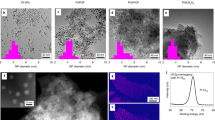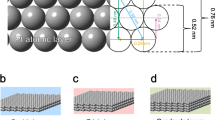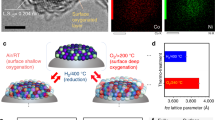Abstract
Platinum functions exceptionally well as a nanoparticulate catalyst in many important fields, such as in the removal of atmospheric pollutants, but it is scarce, expensive and not always sufficiently durable. Here, we report a perovskite system in which 0.5 wt% Pt is integrated into the support and its subsequent conversion through exsolution to achieve a resilient catalyst. Owing to the instability of most Pt oxides at high temperatures, a thermally stable platinum oxide precursor, barium platinate, was used to preserve the platinum as an oxide during the solid-state synthesis in an approach akin to the Trojan horse legend. By tailoring the procedure, it is possible to produce a uniform equilibrated structure with active emergent Pt nanoparticles strongly embedded in the perovskite surface that display better CO oxidation activity and stability than those of conventionally prepared Pt catalysts. This catalyst was further evaluated for a variety of reactions under realistic test environments—CO and NO oxidation, diesel oxidation catalysis and ammonia slip reactions were investigated.

This is a preview of subscription content, access via your institution
Access options
Access Nature and 54 other Nature Portfolio journals
Get Nature+, our best-value online-access subscription
$29.99 / 30 days
cancel any time
Subscribe to this journal
Receive 12 print issues and online access
$259.00 per year
only $21.58 per issue
Buy this article
- Purchase on Springer Link
- Instant access to full article PDF
Prices may be subject to local taxes which are calculated during checkout





Similar content being viewed by others
Data availability
All underlying data is available on the St Andrews PURE website at https://doi.org/10.17630/3f58e258-5b0d-4e12-9742-e89bb844b062.
References
Farrauto, R. J. Low-temperature oxidation of methane. Science 337, 659–660 (2012).
Zhang, Z. et al. Thermally single atom Pt/m-Al2O3 for selective hydrogenation and CO oxidation. Nat. Comm. 8, 16100 (2017).
Jones, J. et al. Thermally single-atom platinum-on-ceria catalysts via atom trapping. Science 353, 150–154 (2016).
Nie, L. et al. Activation of surface lattice oxygen in single-atom Pt/CeO2 for low-temperature CO oxidation. Science 358, 1419–1423 (2017).
Winkler, S. L. et al. Vehicle criteria pollutant (PM, NOx, CO, HCs) emissions: how low should we go? npj Clim. Atmos. Sci. 1, 26 (2018).
Hwang, J. et al. Perovskites in catalysis and electrocatalysis. Science 358, 751–756 (2017).
Kim, C. H., Qi, G., Dahlberg, K. & Li, W. Strontium-doped perovskites rival. Science 327, 1624–1627 (2010).
Tanaka, H., Taniguchi, M., Uenishi, M., Kajita, N. & Tan, I. Self‐regenerating Rh‐ and Pt‐based perovskite catalysts for automotive‐emissions control. Angew. Chem. 45, 5998–6002 (2006).
Jarrige, I. et al. Toward optimizing the performance of self-regenerating Pt-based perovskite catalysts. ACS Catal. 5, 1112–1118 (2015).
Nishihata, Y. et al. Self-regeneration of a Pd-perovskite catalyst for automotive emissions control. Nature 418, 164–167 (2002).
Zhang, S. et al. New atomic-scale insight into self-regeneration of Pt-CaTiO3 catalysts: incipient redox-induced structures revealed by a small-angle tilting STEM technique. J. Phys. Chem. C 121, 17348–17353 (2017).
Malamis, S. A. et al. Comparison of precious metal doped and impregnated perovskite oxides for TWC application. Catal. Today 258, 535–542 (2015).
Katz, M. B. et al. Self-regeneration of Pd-LaFeO3 catalysts: new insight from atomic-resolution electron microscopy. J. Am. Chem. Soc. 133, 18090–18093 (2011).
Neagu, D., Tsekouras, G., Miller, D. N., Ménard, H. & Irvine, J. T. S. In situ growth of nanoparticles through control of non-stoichiometry. Nat. Chem. 5, 916–923 (2013).
Neagu, D. et al. Demonstration of chemistry at a point through restructuring and catalytic activation at anchored nanoparticles. Nat. Commun. 8, 1855 (2017).
Neagu, D. et al. Nano-socketed nickel particles with enhanced coking resistance grown in situ by redox exsolution. Nat. Commun. 6, 8120 (2015).
Gao, Y., Wang, J., Lyu, Y.-Q., Lam, K. & Ciucci, F. In situ growth of Pt3Ni nanoparticles on an A-site deficient perovskite with enhanced activity for the oxygen reduction reaction. J. Mater. Chem. A 5, 6399–6404 (2017).
Nur, A. S. M. et al. Phase-dependent formation of coherent interface structure between PtO2 and TiO2 and its impact on thermal decomposition behavior. J. Phys. Chem. C 122, 662–669 (2018).
Haradem, P. S., Chamberland, B. L., Katz, L. & Gleizes, A. A structural model for barium platinum oxide, Ba3Pt2O7. J. Solid State Chem. 21, 217–223 (1977).
Sakthivel, C., Keerthana, L. & Prabha, I. Current status of platinum based nanoparticles: physicochemical properties and selected applications—a review. Johnson Matthey Technol. Rev. 63, 122–133 (2019).
Myung, J.-H., Neagu, D., Miller, D. N. & Irvine, J. T. S. Switching on electrocatalytic activity in solid oxide cells. Nature 537, 528–531 (2016).
Jeon, Y. et al. Hollow fibers networked with perovskite nanoparticles for H2 production from heavy oil. Sci. Rep. 3, 2902 (2013).
ACE Tech Team. Aftertreatment Protocols for Catalyst Characterization and Performance Evaluation: Low-Temperature Oxidation Catalyst Test Protocol (USDRIVE, 2015); https://cleers.org/wp-content/uploads/2015_LTAT-Oxidation-Catalyst-Characterization-Protocol.pdf
Acknowledgements
We acknowledge useful discussions with M. Fowles and J. Fisher from Johnson Matthey. We thank the Diamond Light Source for the award of beam time as part of the Energy Materials Block Allocation Group SP14239. Funding was from Johnson Matthey, EPSRC for a CASE PhD studentship, EPSRC for a Critical Mass project EP/R023522/1 and electron microscopy provision EP/R023751/1 and EP/L017008/1. We dedicate this work to our esteemed co-author and colleague David Wails who tragically died in the attacks in Reading, UK, on 20 June 2020. David was a talented scientist who had dedicated his career to advancing sustainable catalysis and mentoring early career researchers.
Author information
Authors and Affiliations
Contributions
M.K. and Y.J. designed and carried out the experiments, and wrote the manuscript. D.N.M. collected the TEM and energy dispersive X-ray data. S.R. and A.C. analysed the XANES/EXAFS results. A.E.P. and J.K. carried out the conventional catalyst tests at Johnson Matthey and D.W. and J.F. analysed the results. J.T.S.I. supervised the whole study and revised the manuscript. All the authors discussed the results and commented on the manuscript.
Corresponding author
Ethics declarations
Competing interests
The authors declare no competing interests.
Additional information
Peer review information Nature Chemistry thanks Abhaya Datye and the other, anonymous, reviewer(s) for their contribution to the peer review of this work.
Publisher’s note Springer Nature remains neutral with regard to jurisdictional claims in published maps and institutional affiliations.
Supplementary information
Supplementary Information
Supplementary Figs. 1–11 and Tables 1–4.
Rights and permissions
About this article
Cite this article
Kothari, M., Jeon, Y., Miller, D.N. et al. Platinum incorporation into titanate perovskites to deliver emergent active and stable platinum nanoparticles. Nat. Chem. 13, 677–682 (2021). https://doi.org/10.1038/s41557-021-00696-0
Received:
Accepted:
Published:
Issue Date:
DOI: https://doi.org/10.1038/s41557-021-00696-0
This article is cited by
-
Self-assembled FeRu bimetallic nanocatalysts for efficient and durable mutual CO–CO2 conversion in a reversible solid oxide electrochemical cell
Science China Materials (2024)
-
Atomically dispersed materials: Ideal catalysts in atomic era
Nano Research (2024)
-
Nanoparticle Exsolution on Perovskite Oxides: Insights into Mechanism, Characteristics and Novel Strategies
Nano-Micro Letters (2024)
-
Reverse oxygen spillover triggered by CO adsorption on Sn-doped Pt/TiO2 for low-temperature CO oxidation
Nature Communications (2023)
-
NaNO3-mediated synthesis of Pt-doped titanate perovskites for oxygen-reduction reactions in acidic media
Journal of Sol-Gel Science and Technology (2023)



